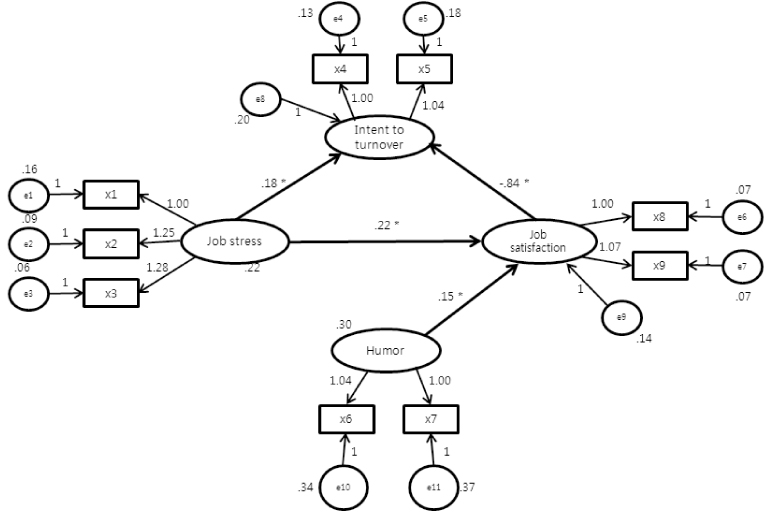J Korean Acad Nurs Adm.
2013 Mar;19(2):265-272.
Structural Equation Modeling for Humor, Job Satisfaction, Job Stress and Intention to Turnover
- Affiliations
-
- 1Department of Nursing, Baekseok University, Korea. jhkimrn@bu.ac.kr
Abstract
- PURPOSE
This study was done to identify the effects and relationships of humor, job satisfaction, job stress and intent to turnover for nurses and suggest a theoretical structural path diagram among the variables.
METHODS
Data were collected at 6 hospitals located in Seoul, and Gyeonggi Province, from June to September, 2010. Participants were 275 nurses. Data were analyzed using Amos 19.0 for Structural Equation Modeling.
RESULTS
Humor had significant effects on job satisfaction (beta=.15, t=2.29, p=.022) and indirect effects on the intent to turnover in this model (chi2=44.18, df=23, RMSEA=0.05, TLI=0.97). But humor did not affect job stress unlike results of previous studies (t=-.02, p=.771).
CONCLUSION
Humor may not affect job stress under the very stressful conditions of the health care environment. The model showed the effect of humor contributed to increases in job satisfaction but did not decrease job stress. Higher levels of job satisfaction could decrease the intent to turnover. Consequently, humor would be helpful in increasing job satisfaction to diminish nurse turnover. Further studies are suggested to investigate causal relationships among humor, burnout, and other emotional and organizational variables.
Keyword
Figure
Reference
-
1. Chinery W. Alleviating stress with humour: A literature review. J Perioper Pract. 2007. 17:172–182.2. Healy CM, Mackay MF. Nursing stress: The effects of coping strategies and job satisfaction in a sample of Australian nurses. J Adv Nurs. 2000. 31:681–688. http://dx.doi.org/10.1046/j.1365-2648.2000.01323.x.3. Hsieh CJ, Hsiao YL, Liu SJ, Chang C. Positive psychological measure: Constructing and evaluating the reliability and validity of a Chinese humor scale applicable to professional nursing. J Nurs Res. 2005. 13:206–215.4. Jun JY, Kim MS. A study on the nurses' appreciation and use of humor. J Korean Acad Adult Nurs. 2004. 16:366–377.5. Kim CH, Yang SS, Kim YJ, Son YJ, You MA, Song JE. A structural equation model of nurses' turnover intention. J Korean Acad Nurs Adm. 2009. 15:550–562.6. Kim DS, Kang NJ. Regression analysis, basics and applications. 2000. Seoul: Nanam.7. Kim JH. Analysis of the clinical nurses' organizational commitment and relating variables. J Korean Acad Nurs Adm. 1996. 2:125–138.8. Kim MJ, Gu MO. The development of the stress measurement tool for staff nurses working in the hospital. J Nurs Acad Soc. 1984. 14:28–37.9. Kim MR. Relationship between sense of humor and job stress of nurses. 2009. Cheongju, Korea: Chongbuk National University;Unpublished master's thesis.10. Kim MS. A study on the nurses' appreciation and use of humor. 2004. Busan, Korea: Dong-Eui University;Unpublished master's thesis.11. Kline RB. Principles and practice of structural equation modeling. 1998. New York: Guilford press.12. Lee SK. A study on the relationship between autonomy and group cohesiveness perceived by nurses and their job satisfaction, organizational commitment, motivation and intent to stay on jobs. 1996. Seoul, Korea: Seoul National University;Unpublished master's thesis.13. Lee YJ. The effect of registered nurses humor style on job satisfaction and organizational commitment. 2010. Seoul, Korea: Myongji University;Unpublished master's thesis.14. Martin RA. Sense of humor and physical health: Theoretical issues. Humor. 2004. 17:1–19.15. Martin RA. Psychology of Humor: An integrative approach. 2006. Amsterdam: Elsevier.16. McCreaddie M, Wiggins S. The purpose and function of humour in health, health care and nursing: A narrative review. J Adv Nurs. 2008. 61:584–595. http://dx.doi.org/10.1111/j.1365-2648.2007.04548.x.17. McLaughlin AM, Friedman J. Rehabilitation staff stress as it relates to patient acuity and diagnosis. Brain Inj. 1992. 6:59–64.18. Oh EH, Chung BY. The effect of empowerment on nursing performance, job satisfaction, organizational commitment and turn over intention in hospital nurses. J Korean Acad Nurs Adm. 2011. 17:391–401.19. Olsson H, Backe H, Sorensen S, Kock M. The essence of humour and its effects and functions: A qualitative study. J Nurs Manag. 2002. 10:21–26. http://dx.doi.org/DOI:10.1046/j.0966-0429.2001.00272.x.20. Perry TR. The certified registered nurse anesthetist: occupational responsibilities, perceived stressors, coping strategies, and work relationships. AANA J. 2005. 73:351–356.21. Seashore SE, Lawler EE, Mirvis P, Cammann C. Observing and measuring organizational change: A guide to field practice. 1982. New York: Wiley.22. Son HS. The Relationship between nurses' sense of humor and empowerment. 2008. Suwon, Korea: Ajou University;Unpublished master's thesis.23. Sung TG, Si GJ. Research methodology. 2007. Seoul: Hakjisa.24. Svebak S, Kristoffersen B, Aasarød K. Sense of humor and survival among a county cohort of patients with end-stage renal failure: A two-year prospective study. Int J Psychiatry Med. 2006. 36:269–281. http://dx.doi.org/10.2190/EFDR-CMDW-X8MH-WKUD.25. Wanzer M. "If we didn't use humor, we'd cry": Humorous coping communication in health care settings. J Health Commun. 2005. 10:105–125. http://dx.doi.org/10.1080/10810730590915092.26. Yom YH, Ko MS, Kim GK, Kim TS, Min S, Park JS, et al. Nursing management. 2007. Seoul: Soomoonsa.27. Yoon JA, Lee HJ. Internal marketing, job stress, organization commitment and turnover intention in nursing organization. J Korean Acad Nurs Adm. 2007. 13:293–301.28. Yu NS. The differences about nursing practice activity, working environment, body mechanics, job stress and job satisfaction between low back pain group and no low back pain group in ICU nurses. 2006. Seoul, Korea: Ewha Womans University;Unpublished master's thesis.
- Full Text Links
- Actions
-
Cited
- CITED
-
- Close
- Share
- Similar articles
-
- A Structural Model of Hospital Nurses' Turnover Intention: Focusing on Organizational Characteristics, Job Satisfaction, and Job Embeddedness
- The Influence of Job Stress and Job Satisfaction on Turnover Intention for Male Dental Hygienists
- Literature Review of Structural Equation Models for Hospital Nurses' Turnover Intention in Korea
- Effect of Job Embeddedness and Job Satisfaction on Turnover Intention in Nurses
- Effects of Job Crafting, Burnout, and Job Satisfaction on Nurses' Turnover Intention: A Path Analysis



